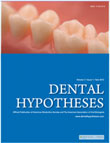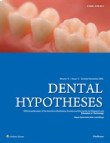فهرست مطالب

Dental Hypotheses
Volume:5 Issue: 1, Jan-Mar 2014
- تاریخ انتشار: 1393/02/13
- تعداد عناوین: 9
-
-
Helicobacter pylori-possible role as biomarker for oral cancerPages 3-6Oral cancer is the most common cancer diagnosed in Indian men and is the leading cause of cancer deaths. Amongst other causes infections with Helicobacter pylori is an emerging cause of oral squamous cell carcinoma. There is still confusion in the route of transmission and the exact etiopathogenesis of H. pylori associated oral cancer. Knowledge of the microbiology and immunology of H. pylori is important to prevent its spread and may be useful in identifying high-risk populations, especially in areas that have high rates of gastric lymphoma, gastric cancer, and gastric ulcer. This paper presents an overview of the important aspects of H. pylori.
-
Pages 7-10IntroductionTrauma, altered tooth germ position and delayed tooth eruption have been hypothesized as possible causes of tooth root dilacerations and flexion, however these anatomical variations appear more commonly associated with posterior teeth and absence of traumatic history. The Hypothesis: Postulated is that tooth root dilaceration or flexion may be a result of tooth root sheath displacement due to gradients of bone remodeling present within alveolar bone. Evaluation of the Hypothesis: Alveolar bone displays bone remodeling gradients between coronal, apical and basal sections which affect bone plasticity. As a tooth is erupting or experiences delayed eruption, there are other relative dento-skeletal alterations occurring, such as the mesial drift of the dentition and transverse growth of the maxilla. It is plausible that during the physiologic and growth related alteration of the alveolar and basal bones, portions of developing tooth could be found within one or more of the plasticity zones, contributing to alteration of the root sheath and tooth root dilaceration.
-
Pages 11-13IntroductionThere are reports in the literature, which describe different techniques and materials in the challenging management of thin dentin walls and immature root apex. It has been suggested that calcifying nanoparticles (CNPs) could be used in the management of these conditions. The Hypothesis: Compositionally modified CNPs made into a paste could become efficacious in managing thin dentin walls and immature root apex. Calcium and phosphate ions when mixed with CNPs could form a synthetic nanopaste that clinicians could use to manage thin dentin walls and to get a biological seal for immature root apex. Evaluation of the Hypothesis: CNPs can replicate and could facilitate the aggregations of calcium hydroxyapatite to produce a self-surrounding shell. These characteristics of CNPs could be used through their biomineralization process as initial nidus of calcification for further calcification progression to achieve total biological apical seal. If the hypothesis could be supported by biomineralization behavior of the paste (CNPs, Ca2 +, and PO4−), a new therapeutic agent would have been added to the armamentarium of endodontists. There is need for more in vivo and in vitro investigations of modified nanopaste to manage these conditions.
-
Pages 14-15IntroductionEncountering environmental situations that have an adverse effect on the properties of Mineral Trioxide Aggregate (MTA) is inevitable and unfortunately common. In many cases MTA does not set and the clinician is forced to apply this cement again. This occurrence may affect the outcome of endodontic treatments such as perforation repair. Therefore, strategies should be considered to overcome this matter. Various studies have been conducted that mixed several substances with MTA to reverse the adverse effects on this material but still we face this problem. The Hypothesis: In this paper, we propose a hypothesis that mixing MTA with phosphate buffered solution (PBS) may reverse the adverse environmental effects and may help us overcome this clinical problem. Evaluation of the Hypothesis: PBS is a synthetic solution containing phosphate which is commonly used for mimicking in vivo situations in laboratory studies. Considering that some studies have shown that when MTA encounters tissue fluids containing phosphorous its properties improve, we suggest that mixing this cement with PBS can at least reverse the adverse effect of the environment. It should be noted that the better the properties of these cements, the better the outcome of treatment can be.
-
Pages 16-20ObjectivesTo propose a new classification of median maxillary labial frenum (MMLF) based on the morphology in permanent dentition, conducting a cross-sectional survey.Materials And MethodsUnicentric study was conducted on 2,400 adults (1,414 males, 986 females), aged between 18 and 76 years, with mean age = 38.62, standard deviation (SD) = 12.53. Male mean age = 38.533 years and male SD = 12.498. Female mean age = 38.71 and female SD = 12.5750 for a period of 6 months at Teerthanker Mahaveer University, Moradabad, Northern India. The frenum morphology was determined by using the direct visual method under natural light and categorized.ResultsDiverse frenum morphologies were observed. Several variations found in the study have not been documented in the past literature and were named and classified according to their morphology.DiscussionThe MMLF presents a diverse array of morphological variations. Several other undocumented types of frena were observed and revised, detailed classification has been proposed based on cross-sectional survey.
-
Pages 21-24IntroductionOne of the developmental anomalies of dental enamel is cervical enamel projection (CEP). The aim of this study was to assess the prevalence of CEP in maxillary and mandibular human teeth.Materials And MethodsA total of 234 human molars obtained from the tooth bank of the State University of Amazonas were used in the present study. CEP was classified as Grade 0 (absence of projection), Grade I (discrete extension of cementoenamel junction toward the furcation), Grade II (closer to furcation without invasion), and Grade III (extending to the furcation area). The evaluation was performed using macroscopic inspection of teeth faces (buccal, lingual/palatal, mesial, and distal) with at least one-third of the crown on each face.ResultsIt was found that 17.1% of the teeth evaluated had CEP, but neither of the projections occurred on the proximal faces. Higher prevalence of CEP was found on the buccal faces and the most commonly grade of CEP found was Grade I (10.3%).ConclusionsIt may be concluded that CEP occurs more frequently in mandibular molars and its diagnosis is extremely important since these projections may difficult bacterial plaque removal, leading to an inflammatory process and unnecessary endodontic treatment.
-
Pages 25-27IntroductionAbutment screw loosening has been considered as a common complication of implant-supported dental prostheses. This problem is more important in cement-retained implant restorations due to their invisible position of the screw access opening. Case Report: This report describes a modified retrievability method for cement-retained implant restorations in the event of abutment screw loosening. The screw access opening was marked with ceramic stain and its porcelain surface was treated using hydrofluoric acid (HF), silane, and adhesive to bond to composite resin.DiscussionThe present modified technique facilitates screw access opening and improves the bond between the porcelain and composite resin.
-
Pages 28-32The presence of foreign object in the root canal is one of the challenging occurrences in endodontic therapy. The possibility of these foreign objects getting impacted into the tooth is more when pulp chamber is open either due to trauma or due to large carious lesion. We herewith report a case of a 12-year-old boy who presented with staple pin lodged in the root canal of maxillary right permanent central incisor. We also describe the management of the case and microbiological analysis of the foreign body.


